Summary of Internet Art
Advances in telecommunications technology have inspired artists to create artworks that made use of global connectivity, real-time information sharing, and a visual interface that can be displayed anywhere with computer hardware and an internet connection. With this new medium also came opportunities for original creative endeavors, such as the creation of an interactive story-telling experiences and modifications of existing internet content as a work of art. Due to the massive social and cultural shifts that the internet has brought on, internet artists have also been at the forefront of artistic experiments that reflect on contemporary culture.
Key Ideas & Accomplishments
- Internet artists harnessed technology to allow the kind of real-time collaboration and interactivity that had not been possible before, resulting in a new type of art that is open-ended, digital, and participatory in nature.
- Since the substance of Internet Art is not dependent on a material base (such as a canvas), it can exist simultaneously in multiple locations beyond specific physical properties. More so than most artistic movements, therefore, Internet Art came the closest to circumventing the art market and breaking the barrier between artist and viewer, which have been a long-running theme in avant-garde art.
- Internet artists were active contributors to ideas about open access and the commons, which enabled "remix" culture and supported creative practices in the digital age beyond the restrictions of traditional copyrights and intellectual property.
Artworks and Artists of Internet Art
La Plissure du Texte
Roy Ascott's La Plissure du Texte was one of the first artworks to utilize ARTEX, a proto-internet text-based communication technology. The concept was to create a fictional narrative with participants from around the world. Each participant assumed the role of a specific character and identity based on their location. They collectively improvised a narrative via ARTEX instant messaging. There were ten participating international locations, each one assigned a specific fairytale character.
Fellow participant Norman White described the experience as a fantastical tale, "whereby [the task of] writing a storybook text was shared by characters assigned to each city. For instance, Pittsburgh was the Prince; and Toronto, the Fairy Godmother, and so on. You'd log into the I.P. Sharp system [which supported ARTEX], and see what the other characters were up to. It was totally impromptu, you didn't know where the story would lead. This went on for two weeks."
La Plissure du Texte was a forerunner to collaborative Internet Art made using social media platforms and applications like Tumblr, MySpace, and Twitter. In allowing all participants to have a say in the narrative, the piece echoes artistic practices in the twentieth century that sought to move away from individual agency, that is, the decision making of the artist alone, and toward collective ownership and participation. ARTEX provided an infrastructure for such a collaboration on a scale and at a speed that had not been possible previously.
Interactive artwork using ARTEX computer systems
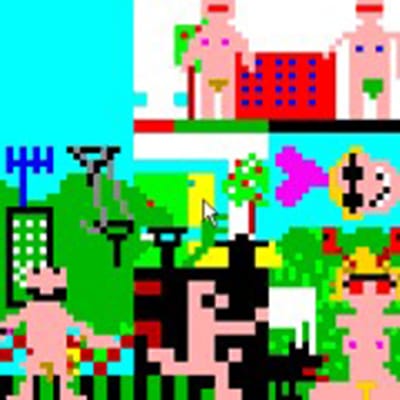
Poietic Generator
With a nod to the Surrealist parlor game Exquisite Corpse, Poietic Generator is an artistic game where every player draws on a small part of a digital graphics matrix to create a global mosaic. The term "poietic" refers to both autopoiesis in life sciences (meaning a system capable of producing and maintaining itself) and from philosophy of art (meaning productive or formative). Unlike Exquisite Corpse, which hides the prior artist's imagery until each player has finished, Poietic Generator displays each player's drawings in real-time. Out of this collaborative process, which may involve several thousand players at a time, emerges "a cybernetic loop," writes Auber, that forms "a kind of narrative: autonomous forms, sometimes abstract, sometimes figurative, appear in a completely unpredictable manner and tell stories."
The piece began in 1987 and was transmitted through the Minitel system. A later version became available to anyone using a PC computer connected to the internet in 1997. In 2012, a mobile version was also developed after a crowd-funding campaign. From the start Auber had envisioned the piece as an artwork that would be free. From the Minitel to mobile apps, the piece had also tracked the widening reach of telecom technology for personal use. Like La Plissure du Texte, it provides a scaffolding for shared authorship, in this case including authorship by those outside of a predetermined group.
King's Cross Phone-In
Heath Bunting was a member of the art collective irrational.org, whose mission included the use of artistic interventions to disrupt daily operations within public life. They often relied on the internet to communicate and disseminate information.
On August 5, 1994 Bunting devised a participatory performative action where volunteers called thirty-six public phones located in and around the vicinity of London King's Cross railway station throughout the course of the day. In order to solicit participation, Bunting used a website, various newsgroups, and email lists, where he listed the phone numbers and explained the logistics of the intervention, for example, the date that people should call the numbers. The frequent intentional calls created a symphonic cacophony within the vicinity of the train station. Unwitting onlookers were faced with the option of ignoring the calls or answering them. Calling participants were encouraged to "have a chat" with any commuters who picked up the ringing phones.
King's Cross Phone-In is a prime example of how technology could be used as a mediator between virtual and real-world situations. Art writer Dylan Kerr describes the piece as a "proto-flash mob," noting that, like Bunting, "many of the early [internet] artists were less concerned with making aesthetically-pleasing web pages than they were with harnessing and exploring the entirely novel power of the Internet, often in ways that extended far beyond their computer screens." In King's Cross Phone-In, we see the potential of networked communication that can spill into real-life organizing as would, in later decades, be the case with protest coordination and political organizing. This aspect of Internet Art is one of the reasons why some critics have viewed it as one of the more disruptive forces in contemporary art in the last few decades.
Art hacktivism performance
My Boyfriend Came Back From the War
My Boyfriend Came Back From the War reflects the geopolitical tensions of the 1990s and the emotional impact of war and the military-industrial complex. The specific war or conflict is not mentioned in the artwork's guided narrative. The premise is a couple's reunion and the toll of post-war trauma on their relationship.
To display this artwork to the world, Lialina, who is from Russia, set up a website that deployed an interactive storytelling experience. Visitors to the site were presented with a fictional dialogue between two characters. As users clicked on hyperlinks, the story progressed, revealing new imagery, text, and prompts. No matter which prompt a viewer chose, however, the story did not go well.
The slow internet connection back then caused the imagery of the website to load slowly. Rather than seeing this as a drawback, Lialina noted that it was beneficial for the viewing experience of her work. "I wanted to make something," she said, "that people would spend time with and look at in the browser."
My Boyfriend Came Back From the War is an example of early Internet Art's use of web-specific features, specifically the use of hyperlinks to create an interactive and aesthetic experience, like a choose-your-adventure storybook but now without the physical limits of printed matter. It is also one of the most notable and influential political artworks on the web. In 2016, twenty years after its creation, the piece was exhibited using emulation software to replicate the original work as it had appeared on a (by then obsolete) browser. The exhibition served as an example of ongoing efforts to preserve variable media artworks.
Browser-based internet artwork
Form Art
Form Art used the aesthetic and functionality of early websites to create an interactive experience. Aligning with Internet Art's emphasis on the malleability of medium, its display depended on the viewer's operating system, which dictated how the imagery would appear on their screen.
The website for Form Art contained minimal web forms, buttons, and blank boxes, which required visitors to click through to discover more boxes, buttons, and forms. The aimless and rather absurdist experience of clicking these features may be seen to demonstrate the theory of the rabbit hole. According to technology writer and editor Ivy Wigmore, the internet's use of hyperlinks and other interactive forms that take a user from one location to another is a voluntary trip down "the rabbit hole," in which "an individual sets off on the path with a goal, gets sidetracked by various events and changes direction several times along the way, eventually ending up somewhere unexpected, typically without having satisfied the original purpose of the quest." The term has become a common and colloquial way of describing online activities in which users lose track of time on the Web with no ostensibly productive outcome.
Form Art also parodies the burdensome aesthetic of bureaucratic online forms, surveys, and applications, by turning routine and banal tasks into a never-ending Dada-esque game, in which there is ostensibly no deeper meaning behind the task or the artistic activity. It also echoes earlier Fluxus work by artists such as George Maciunas, who used paperwork (card files, charts, documents, etc.) to comment on modern bureaucracy and administrative culture, as art historian Colby Chamberlain has argued.
Interactive website
GEO GOO
Global Positioning System, or GPS, has become a ubiquitous part of everyday life navigation, especially after the rise of the smartphone. At the cusp of this sea change (the first iPhone was released in 2007), the internet artist collective JODI utilized Google Maps to distort and abstractly render its geographical information. JODI is known for using the internet as a means to disrupt quotidian experiences. GEO GOO, writes artist Hua Chun Fan, juxtaposes "relations between the internet world built on Google Maps and the other empirical world based on our mental and physical maps." Layering geometrical constructs, digital representations of reality, and image manipulation, GEO GOO adopted Google Maps's common iconography (such as map pins and symbols for places of interest), user-created routes, and terrain to reframe its functionality into playfully new and fantastical modes of navigating digital environments.
The piece opens up possibilities for reimagining pre-existing internet infrastructure for aesthetic purposes, while prompting us to consider our reliance upon GPS and internet wayfinding instead of trusting our own eyes, navigational knowledge, and lived experience. GEO GOO can also be interpreted as a digital age reference and homage to the history of cartography, when some traditional European mapmakers expressed artistic liberty by adding in sea monsters and other fantasy creatures as a form of decoration.
Manipulated Google Maps landscapes
Public Domain
Public Domain is an online gallery of randomized GIFs, each with its own ornate digital frame. The display format, with artworks "hung" shoulder to shoulder on a (digital) wall, harkens back to the days of salon-style art exhibition, such as in fine art academies in the eighteenth century. Rather than an exclusive realm of culture and prized possessions, however, Antonellis's gallery is free and accessible to anyone with an internet connection. Furthermore, the artworks shown are all, as its title notes, in the public domain, meaning anyone could save the files and use it for whichever purpose.
Antonellis explains: "I bought a CD on eBay advertised to contain over 30,000 public domain animated gifs. Costing £5 after shipping, it was my largest GIF purchase to date. [...] With each refresh, a framed selection of 300 random images is pulled from the archive," like a constantly shifting exhibition curated by chance, with minimal mounting cost. The use of GIF files found on eBay as material harkens back to the notion of "found objects" and the readymade, except the objects are now digital. As the title suggests, the piece thematizes questions of ownership and authenticity and reflects on the image-saturated conditions of internet visual culture. At its center is the tension between the utopian dream of free image generation and circulation enabled by the appropriate software and the internet, on the one hand, and, on the other, the condition of uniqueness and material singularity that undergirds the workings of the art world tracing back to its salon exhibition origins.
Website using public domain GIFs
Beginnings of Internet Art
Telematic Art and Proto-Internet Art
The use of computer-mediated networks to create and display artwork dates back to the 1960s and 1970s, when artists were exploring the potential of early computer technology. Artists took advantage of developments in telecommunications networks, which led to prototypical examples of Internet Art. These early works made use of rudimentary end-user information systems, such as telephone modems and videotex, an interactive hardware and software system that displayed text and graphics onto a video monitor. The first widespread videotex platform was the French-produced Minitel, which could be seen as a predecessor to the internet because it allowed users to send text-based instant messages across the world.
One of the better-known proto-internet artists is Roy Ascott. Ascott had been interested in cybernetics (the science of communication and automatic control systems) since the late 1960s, when he recognized that technology would play a defining role on the course of civilization. Ascott encouraged artists to develop creative and socially conscious work that reflected the experiences and ongoing developments of the coming digital age. Ascott considered art to be time-based, meaning that its perception and interpretation changes and is determined by the duration it exists in the world, as well as how viewers can interact with it. Beginning in the 1970s, his work incorporated computers and telecommunications networks. He coined the term "telematic art" (from "tele-" meaning far off, over a distance) to describe the interdisciplinary connections between visual art and computer science.
Videotex and Minitel
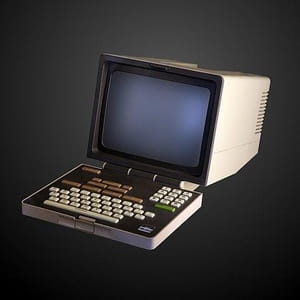
According to musician and critic Daniel Hunt, as videotex technology began to be adopted, different countries implemented different versions under names such as Viewdata in the UK (the first system in operation, later changed to Prestel), Teletel in France (later changed to Minitel), Telidon in Canada, Captains in Japan, and Videotext in the US.
Eduardo Kac was an influential figure among a group of contemporary Brazilian artists in the 1980s who utilized telecom systems to make work. In Brazil, the rise of network-based art was in part a reaction to the country's military dictatorship. In opposition to the government's promotion of nativism (a xenophobic nationalist ideology), there was a desire to partake in globalization. This led to a technological revolution, including a Brazilian version of the French Minitel system, called Videotexto. The system became quite popular throughout the country, reaching approximately 70,000 users by 1995.
Using Videotexto, artists were able to create experimental works of art that could be shared across the network. One notable example is Kac's explorations in making animated poems from 1985 to 1986. Kac drew inspiration from the 1959 Neo-Concrete manifesto, "which argued that a poem or text is fundamentally dynamic and should be considered as an element within an overall three-dimensional environment," explains Net Art Anthology. Using Videotexto allowed Kac to achieve the complex animated permutations and combinations of a text, such as in Reabracadabra, which resulted in as much a visual artwork as an exploration of poetic language. It is a form of text-based art reminiscent of Conceptual Art and Fluxus but now enhanced and distributed by newer technology.
The use of videotex declined after 1991, as the internet became more prevalent and available to the global community. However, the draw of early telematic platforms continue to inspire contemporary artists such as Armandine Chasle and Dan Farrimond, who use the Minitel as a retro technology.
ARTEX
The Artists' Electronic Exchange system (ARTEX) came about thanks to computer programmer Bob Bernecky's interest in the arts. Bernecky was the chief programmer for Canadian computer firm I.P. Sharp Associates (IPSA), which operated a system providing a worldwide network of computer services to businesses via telephone. Curious about the creative and aesthetic potential of the APL coding language that they were using, Bernecky approached his friend Norman White in the late 1970s and suggested that he use APL to make art. White recalls, "APL uses all these weird symbols and even though I was smarter than I am now, I was not up to mastering them. After a few tries, I decided it was a waste of time. However I was not put off by I.P. Sharp's system itself because of the communications tentacles it had all over the world."
White followed up by approaching other artists from across the world to participate in creative experiments using IPSA's network. The first instance of this artistic use of the system was Interplay, which Bill Bartlett initiated for the "Computer Culture" conference in Toronto in 1979. Interplay was essentially an online chat network where artists located in Canberra, Edmonton, Houston, New York, Toronto, Sydney, Vancouver, and Vienna communicated instantaneously. Interplay demonstrated the benefits of having a simple electronic mail program that artists could use for networking and collaborating. The result was IPSA's ARTBOX, which was rebranded as ARTEX in 1982. IPSA considered ARTEX as a "special interest group." It remained functional until their network was acquired by Reuters in the late 1980s.
Early examples of artworks created via ARTEX include La Plissure du Texte (1983) by Roy Ascott and Hearsay (1985) by White, Laura Kikauka, and Carl Hamfelt. La Plissure du Texte was a collaborative, user-sourced fairy tale, in which participants together contributed to the writing of the story. Hearsay was a telematic work of art that utilized the network nodes of IPSA's system to transmit a text message that inevitably changed with each successive transmission and translation, like a game of telephone. White explained the process: "We sent a message around the world using eight nodes of the I.P. Sharp network, whereby each node was translated into a different language along the way. Nobody along the chain knew what the original message was. The languages used were Spanish, English, Japanese, German, Welsh, and Hungarian, as it went around the world in twenty-four hours, finally arriving back in Toronto." The piece made use of the promise of global networks as enabled by technology. At the same time, in a Dada-like gesture, it raised questions about the difficulty of communications and linguistic fissures.
Web 1.0 and Net.Art
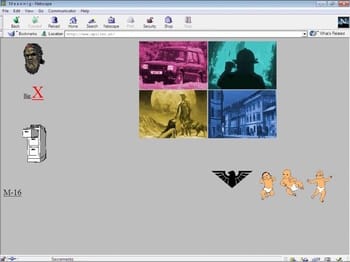
The development of web browsers like Netscape made the internet accessible to households and enabled the first internet boom, in the early 1990s, with the first public websites starting to appear around 1991. Early websites were fairly primitive by today's definition of what a website entails. The initial sites contained static text and image combinations realized via Hyper Text Markup Language (HTML) coding. Not too long afterwards, websites incorporated bold color schemes and kitschy animations. This original era of the internet, in which simple websites served mainly to transmit text-based information, is known as Web 1.0 (The "Web" is short for the World Wide Web, referring to the prevalent, website-based information retrieval system that made the internet accessible and interactive to anyone with a browser and internet connection).
At the time websites often arose in the context of research-based informational systems. Early use of the Web also enabled cross-institutional archive sharing, such as SunSITE, a network of servers jointly run by multiple universities around the world (Sun Microsystems co-sponsored the project and thus its name). For everyday users, websites enabled communication forums for genre-specific or niche interests, for example, Cybergrass (started in 1992), the first website dedicated to bluegrass music.
The early 1990s also saw Internet Art become more established in institutional settings. In 1994, Ascott established a transdisciplinary art and educational platform called Centre for Advanced Inquiry in the Interactive Arts (CAiiA). The program provided a foundational curriculum for new media art. An umbrella term that covers Internet Art, new media art refers to art that uses non-traditional media, such as digital art, computer animation, interactive technologies. In 2003, it became known as the Planetary Collegium and remains part of the Arts and Humanities program at Plymouth University in the United Kingdom.
From the mid-1990s onward, the term net.art gained widespread use. Arts writer and historian Rachel Greene explains that the term "is less a coinage than an accident, the result of a software glitch that occurred in December 1995, when Slovenian artist Vuk Cosic opened an anonymous email only to find it had been mangled in transmission." The only word he was able to discern from the glitch was "net.art," thereby beginning a loosely defined zeitgeist among Cosic and his artistic colleagues.
In 1995, German computer scientist and artist Pit Schultz curated an exhibition of Internet Art at a dance club called Bunker in Berlin. The exhibition featured works by Cosic, Alexei Shulgin, Heath Bunting, and the art collective JODI (formed by Dutch artists Joan Heemskerk and Dirk Paesmans), all known as early adopters of internet-based art or net.art. Although they were often mentioned together by critics, their works were not stylistically similar. Net.art was not a cohesive movement or artistic collective, but the grouping did help to define elements of the genre, especially during its burgeoning period when the internet had a "utopian halo," as Greene puts it. The net.art movement can be understood as a historically specific occurrence in the mid-to -late 1990s within the wider development of Internet Art. According to media theorist and curator Tilman Baumgärtel, characteristic qualities of net.art include "connectivity, global reach, multimediality, immateriality, interactivity and [equality]," with the internet and the socio-cultural developments that it engendered being a common subject matter.
Moscow WWWArt Centre
Founded by Alexei Shulgin in 1995 in Moscow, the WWWArt Centre was one of the first institutional endeavors to showcase work by internet artists. It was an essential project that helped Eastern European artists get noticed for their artworks. Shulgin wrote a manifesto for the art space, highlighting the benefits of the Web as a vehicle for creating, viewing, and promoting art that can exist outside of physical institutional walls. He also gave seminars on the Web and Internet Art, helping to educate a younger generation of artists and to cultivate an audience for the new type and approach of art.
Recognizing the wide variety and approach of internet artists, Shulgin's space enabled artists to experiment with different ways of exhibiting their works. Some of the works shown existed solely on the Web, while others experimented with a hybrid environment of virtual and physical settings.
Rhizome
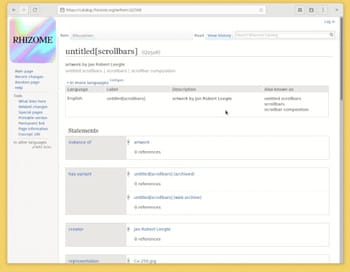
In 1996, American artist Mark Tribe established Rhizome to help contextualize, archive, and promote new media and Internet Art (the two terms are sometimes used interchangeably). The organization began as a simple email list curated by Tribe. It launched its website and became a nonprofit organization in 1998.
Rhizome is notable for its ArtBase, an artist-sourced database of artworks. Since 1999 ArtBase has collected and archived internet and new media artworks including games, software, and interdisciplinary projects that incorporate the Web. Rhizome hosts these works on its server and also engages in digital preservation to ensure that obsolete codes and programming platforms are updated so the work can be viewed as it was originally intended to be. An example of Rhizome's preservation efforts of Web 1.0 and early internet culture is oldweb.today, where viewers can access archived websites within emulated versions of legacy (obsolete) web browsers. Rhizome also supports internet artists and the creation of new art via its commission program.
Concepts and Styles
Social Networking
One of the most revolutionary aspects of internet culture has been social networking, which arose thanks to networked technology's capacity to let people communicate instantly with one another. Technology helped bridge geographical distances and allowed people with similar interests to find each other. ARTEX may be considered the first social network and live online chat system created for and by artists. Later, websites became a primary avenue for virtual social interaction. Early sites incorporated simple message boards and forums for discussing specific themes and topics, such as the Internet Movie Database (IMDb).
"Art on the Net" is one of the earliest online art communities. It was created in 1994 by artist and IT professional Lile Elam to showcase artworks in all mediums by international artists. It is an early example of an online artist portfolio. This concept was followed by DeviantArt, which was founded on August 7, 2000. In addition to being a platform where artists can upload their work and update their public profiles, DeviantArt functions as a social network where artists can message one another, chat on message boards and forums, and collaborate on new works of art. Other influential artist-led web forums include the Icarus Project (2002), which utilizes a network of websites where a diverse global community regularly participates in discussions related to mental health issues.
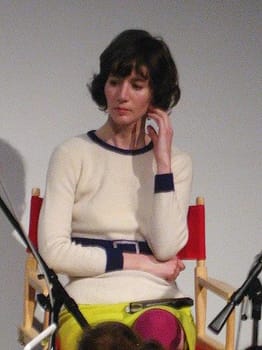
The proliferation of social media during the mid-2000s has been influential in linking people with similar interests across the world, realizing the potential that artists had recognized in ARTEX. In 2014 American performance artist and writer Miranda July launched a mobile messaging service called Somebody as a response to society's growing reliance on social media applications (the number of Facebook monthly active users had surpassed 1 billion the year prior). Somebody sought to use the immediacy and virtual nature of social media communication to form new relationships by connecting two friends via a stranger who operated as a mediator. The premise of the app was that, "when you send your friend a message through Somebody, it goes - not to your friend - but to the Somebody user nearest your friend. This person (likely a stranger) delivers the message verbally, acting as your stand-in." The app forced real-life interactions even as it relied on virtual connections. It may be understood as a commentary on growing concerns about real-life disconnection and the "echo chamber" of social media, in which users only see content and interact with those who already share similar points of view.
Some artists like Kim Kierkegaardashian (a pseudonym combining twenty-first century socialite/influencer Kim Kardashian and nineteenth-century philosopher Søren Kierkegaard) use existing social media applications as their artistic material. Kim Kierkegaardashian's platform of choice is Twitter, where they tweet a mashup of Kardashian and Kierkegaard's writings and musings.
Internet Aesthetics: From Web 1.0 to Web 2.0
Specific types of Internet Art explore material and aesthetic properties of the Web. This means that the art takes common online motifs, visual coding language, and other constructive elements as material for creating new works.
JODI's website, http://wwwwwwwww.jodi.org/, which launched in 1995, is their best-known work. It is an example of how internet artists could upend the form and function of the internet solely for artistic purposes. Embracing an "art for art's sake" ethos, wwwwwwwww.jodi.org is a labyrinth of nonrepresentational internet landscapes created using HTML and linkable to countless other webpages. Clicking from one landscape to another is akin to being in a gallery full of different works of art rendered in an early internet style using simple text, shapes, and overlaid graphics - all effects that mimic glitchy website renderings.
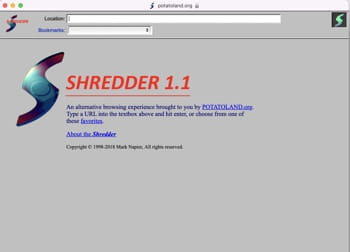
Another example of an artwork made by referencing internet aesthetics is Mark Napier's The Shredder (1998), which acts as a browser but takes graphics and frames from websites and deconstructs them into abstract artworks. The title references physical paper shredding. On The Shredder, users can enter the URL of a website, which is then "shredded" down to small snippets of information and text scattered across the screen.
In addition to Napier, other artists such as Tom Corby and Gavin Baily as well as Maciej Wisniewski also created their own versions of alternative browsers. Corby and Baily describe their project, Reconnoitre (1997-99), as a "dysfunctional browser." The artwork reduced websites down to an abstract display of stark white text and jumbled information. The artists note that although their browser allowed viewers "to search for and access websites, it is less concerned with the coherent display of information as with representing browsing as a behavioral activity." In 1999, Wisniewski created a browser-like media network viewer called Netomat. Conceived as an art project, the piece provided "an open, free-form, and flexible alternative to traditional page-based HTML browsers and search engines." It turned the user-centric activity of browsing the internet into a theatrical experience where viewers were presented with floating images, texts, and forms that enveloped their screen. The work launched at the influential Postmasters Gallery in New York, which supported new media artists. Wisniewski explains that "to have Netomat shown in an art context provokes a different way of thinking about the Web, software, and the network concept. All of these things are now cultural phenomena. I'm asking, 'how do we deal with these things now?'"
The early 2000s saw the rise of Web 2.0, referring to a more sophisticated user experience online that allows interaction and user input mainly through writing. Google Maps, which provides real-time navigation, crowd-sourced information, and search functions is an example of a Web 2.0 experience. With new visual interface and more emphasis on interaction Web 2.0 has spawned the next generation of internet artworks.
In 2008, Jon Rafman mined imagery from Google Maps' Street View function for a project called The Nine Eyes of Google Street View. The project bears resemblance to Street Photography and could be described as a take on Henri Cartier-Bresson for the digital and surveillance age. Unlike the Street Art predecessors, however, the photographs Rafman collected were not taken by humans, but by Google's fleet of Google Maps cars, each fitted with nine cameras atop an extended periscope-like pole. These cameras take panoramic photographs of the surrounding environment as the cars drive by. Although the goal is to map geographical and structural spaces, sometimes the photographs capture people and animals. Rafman selected several images that included these anonymous subjects (their faces blurred by Google), who happened to enter Street View's range of vision, and re-framed them as photographic works of art by posting the images to online galleries. At large, Rafman's project speaks to the nature and ethics of public and private surveillance and documentation of everyday life by internet-based corporate entities.
The changing of the internet's visual aesthetic from Web 1.0 to Web 2.0 has prompted reflection and sometimes nostalgia, with Web 1.0 aesthetic becoming a retro style. Combining internet aesthetics with avant-garde art history, Marisa Olson's Space Junk (2010) is a painting that initially resembles the black monochrome paintings of Kazimir Malevich (c.1915). Upon closer inspection, however, Olson's work reveals a pattern made of flickering stars appropriated from a popular GIF file from the early internet era (GIF, which stands for Graphics Interchange Format, is a short, looping animated graphic). Art critic Gene McHugh writes of this piece that Olson is referencing an "obsolescent" painting style through the use of another obsolescent imagery: a GIF image associated with Web 1.0. "When they combine," writes McHugh, "they each highlight each other's obsolescence. Or, perhaps they highlight the fact of obsolescence."
Institutional Critique
Institutional Critique as an artistic movement dates back to the 1970s, when artists started making artworks that raised awareness about what goes on beyond - or behind--the gallery walls. Questions such as funding and sponsorship (where the money comes from), museums' role in the art market, as well as curation and institutional barriers to women artists and artists of color were some of the questions raised. The institutional critique work of internet artists has been linked to art historical precedents such as the Situationists and their method of detournement, which made use of existing images and text and imposed on them revolutionary content. For internet artists, working between virtual space and the traditional infrastructure of the art world allowed a wider reach for their political message while also responding to contemporary visual and internet culture.
By virtue of Internet Art's innate capacity to exist without a physical site such as a gallery, from the start it had the potential to disrupt the art world. In an article titled "Net Art Vs. the Art World," art critic Whitney Kimball discusses Internet Art that resists traditional art historical and contemporary classifications. Kimball focuses on artist Anthony Antonellis, who was drawn to making countercultural Internet Art because he was stifled by institutional responses to it. Antonellis notes that established art critics and museums have frequently eschewed internet-based artworks or limit access to them in an attempt to create an artificially scarce and exclusive marketplace. "Antonellis conjures mirages of wealth out of websites," writes Kimball, "often as though revolting against the imposters who can't appreciate work unless it comes with a big price tag." Antonellis's artworks include the interactive website putitonapedestal.com, where viewers can engage in a satirical curation of an exhibition by arranging icons of pedestals throughout a virtual gallery space and placing gifs of digital art and artifacts upon them.
Artist collective 0100101110101101.org (Eva Mattes and Franco Mattes) utilizes activist and ad hoc techniques, which are known as "art hacktivism," in order to disrupt the status quo within the art world. Starting in 1998 they developed a fictional artistic persona named "Darko Maver." Maver was described as a Serbian recluse and rebellious character, whose artworks were said to be photographs of realistic murder victim replicas placed against derelict backdrops. The photographs were widely understood to be the artist's attempt to expose the atrocities of contemporary war and genocide in the Balkans. However, the images were actual war-zone photographs sourced from the website rotten.com. Hyped as an edgy underground artist, Maver's work was exhibited at the 48th Venice Biennale in 1999. After the Biennale, 0100101110101101.org revealed that Maver was a fictional character created by them, leading to heated debates in the art world. In their book At The Edge Of Art, Jon Ippolito and Joline Blais explain that, "their message to the world was: while artists are making shocking artwork, absorbed by the market, real violence is being perpetrated and ignored by a media-anesthetized world."
Blogging as Art
The practice of artists creating blogs - and blogging as a means for both self and group expression - is known as an internet Surf Club, which is a reference to the act of "surfing the web." One of the more notable Surf Clubs was Nasty Nets, which was founded in 2006 by a collective of artists who collaborated in mining content from the internet for use as raw material for new works of art. Nasty Nets' blog was maintained from 2006 through 2012.
Other artists who frequently incorporated blogging as an artform include Marisa Olson and Abe Linkoln. Commissioned by the Whitney Museum of American Art, the two collaborated on an online "mix-tape" called Abe & Mo Sing the Blogs (2005-06), in which the artists created songs with lyrics sourced from their favorite blog posts. Olson reflected that, "In our official description of the project, we say that blogs, like the blues, have been credited with channeling the 'voice of the people,' and we wondered if we could identify specific genre conventions on blogs. We were kind of interested in the blog as a stage for 'site-specific' performance."
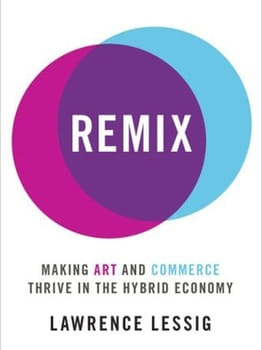
Blogging artists making use of various source materials on the internet is an example of what the legal scholar Lawrence Lessig calls remix culture in his influential book Remix: Making Art and Culture Thrive in the Hybrid Economy published in 2008. An outspoken critic of the traditional copyright system that favors big corporations, Lessing is the founder of the Creative Commons, which formalizes a system of creative licensing tiers to foster collaboration and sharing.
In retrospect, the timing of the blogging art movement and the excitement around remixing were significant as they emerged at the start of the social media boom (Facebook, Tumblr, and Instagram, in particular). From today's vantage point, these works marked a historical moment when the internet was more open-ended, before a handful of social media companies and search engines ("Big Tech") would come to dominate the Web.
Digital Preservation and Variable Media
Like traditional works of art, internet-based art requires maintenance and preservation in order to be continually collected, stored, and displayed. Variable media is a term that defines any work of art that may exist "independently from its [original] medium, allowing the work to be translated once its current medium becomes obsolete," explains The Guggenheim Museum, which helped found the Variable Media Initiative in 1999. Examples of art that fall under this definition include works made using obsolete hard drives, cathode-ray tubes, and old web browsers, applications, and plug-ins. Other related initiatives to conserve and present Internet Art in its intended form include Rhizome and V2_: Lab for the Unstable Media. Various methods have been deployed, including the use of emulators that mimic the form, function, and content of legacy browsers.
Rafeal Rozendaal's artwork is almost exclusively in the form of site-specific, single-page websites. In order to ensure that the websites continue to function and display properly, in 2016 he recorded a video of all his websites. During the course of the two-hour long video, Rozendaal visits each of the 103 websites, discussing how they were made and how they should work, as a reference document for future preservation.
Later Developments - After Internet Art
Post-internet
By the mid-2000s, Internet Art had gained more mainstream exposure and institutional acceptance. Mark Tribe reflected: "Everybody seems to want a piece of the action. With new media exhibitions popping up in major museums from New York to San Francisco, this may be our last chance to reflect on Internet Art's golden age of innocence." During a Rhizome panel, Olson coined the term "post-internet" to describe her work. She explained: "What I make is less art 'on' the Internet than it is art 'after' the Internet. It's the yield of my compulsive surfing and downloading. I create performances, songs, photos, texts, or installations directly derived from materials on the Internet or my activity there." The term caught on, capturing what not only Olson but many of her peers were preoccupied with. In a 2015 article published in The New Yorker, American poet and critic Kenneth Goldsmith defined post-Internet Art as "the practices of artists who ... unlike those of previous generations, [employ] the Web [as] just another medium, like painting or sculpture. Their artworks move fluidly between spaces, appearing sometimes on a screen, other times in a gallery."
The idea of post-Internet Art is somewhat controversial and has exposed an intergenerational rift among internet artists. In heated online discussion threads, formative internet artists and critics have acknowledged certain shifts in the course of Internet Art while eschewing the term "post-internet." In Tribe's assessment, "post-internet artists stand on the shoulders of net.art giants like Olia Lialina, Vuk Cosic, and JODI, not in order to lift themselves higher into the thin atmosphere of pure online presence but rather to crush the past and reassemble the fragments in strange on/offline hybrid forms."
The early and utopian vision of Internet Art being free and accessible to all has also met with the reality of the art market. Rozendaal has sold his website-specific art to collectors via a transfer of domain ownership, which Rozendaal notes is one of the few exclusive elements of the Web, that is, website addresses (for example, theartstory.org), which are unique and therefore can be bought and sold. Regarding how a collection might interpret and display these works, writer Natasha Felizi posits that Rozendaal's oeuvre is comprised of "invariably single-page websites that only offer one experience, which is how we can imagine collectors showcasing their piece, by exhibiting on a mounted computer screen in his or her home." In 2013, Rozendaal's website-artwork, www.ifnoyes.com (2013) was auctioned at Phillips in New York for $3,500.
Known for his early embrace of telecommunications in art-making, Kac declared in 2019: "there's a general misperception when we talk about online culture. Everyone is so obsessed with the internet, but to me, it's a historical phenomenon. It will be superseded by other networks in the future." Indeed, the direction that Internet Art will take will be largely determined by technological evolution, which in the digital age has been happening at a rapid pace. This condition has led to speculative theories about the future of the internet, such as the loosely defined concept of Web 3.0, referring to a more decentralized, blockchain-supported Web (the term was first coined in 2014 but only gained more traction in recent years). It remains to be seen how Internet Art will respond to inevitable changes in network technology.
NFT Art
Internet Art has expanded to include NFTs, which stand for non-fungible tokens. NFTs are best known for their highly speculative value in the marketplace. NFT art can be any digital file of an artwork that has been tokenized onto a blockchain. NFT artworks exist completely in the digital realm, where investors and art collectors can buy and sell them. Although not all NFTs are considered Internet Art, some have referenced internet culture (i.e. memes like Nyan Cat) and even prior Internet Art pieces. Internet artists and post-internet artists like Kim Asendorf and Rozendaal have minted their own NFTs.
The world of NFT art is not without controversy, including being connected to cryptocurrency scams, insider trading, plagiarism of other artist's work, not to mention concerns about NFT's environmental impact. Jon Ippolito writes, "to be sure, a handful of historically conscious artists are creating NFTs with a real connection to the past, often by writing generative code to the blockchain." However, he adds, "for every NFT that reflects a thoughtful engagement with, say, Pop or generative art, NFT marketplaces offer hundreds of faux Roy Lichtensteins and Vera Molnárs 'dropped' out of nowhere into the present-day cultural landscape. These crypto echoes of older artworks and art platforms are not upgrades or ironic remixes - just knock-offs."

















